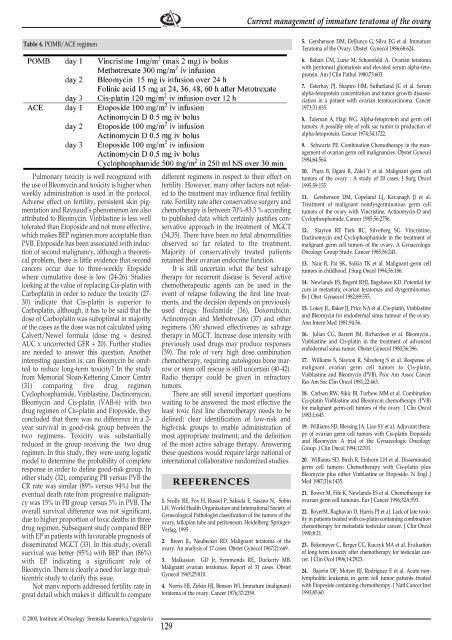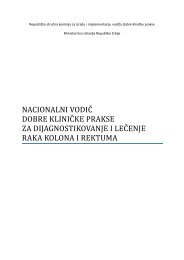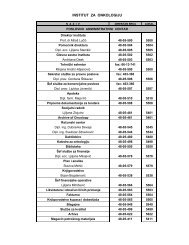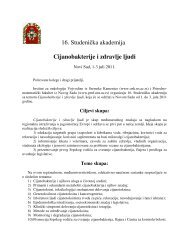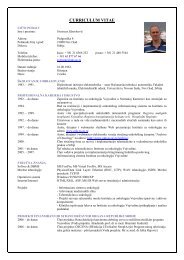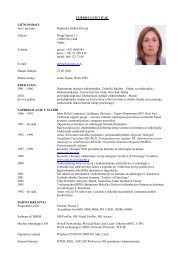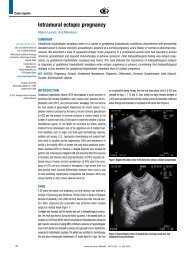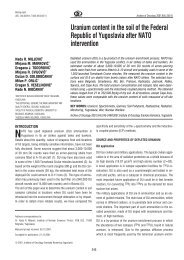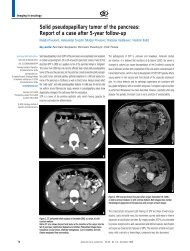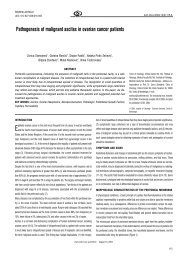Current management of immature teratoma of the ovary
Current management of immature teratoma of the ovary
Current management of immature teratoma of the ovary
You also want an ePaper? Increase the reach of your titles
YUMPU automatically turns print PDFs into web optimized ePapers that Google loves.
<strong>Current</strong> <strong>management</strong> <strong>of</strong> <strong>immature</strong> <strong>teratoma</strong> <strong>of</strong> <strong>the</strong> <strong>ovary</strong><br />
Table 4. POMB/ACE regimen<br />
Pulmonary toxicity is well recognized with<br />
<strong>the</strong> use <strong>of</strong> Bleomycin and toxicity is higher when<br />
weekly administration is used in <strong>the</strong> protocol.<br />
Adverse effect on fertility, persistent skin pigmentation<br />
and Raynaud’s phenomenon are also<br />
attributed to Bleomycin. Vinblastine is less well<br />
tolerated than Etoposide and not more effective,<br />
which makes BEP regimen more acceptable than<br />
PVB. Etoposide has been associated with induction<br />
<strong>of</strong> second malignancy, although a <strong>the</strong>oretical<br />
problem, <strong>the</strong>re is little evidence that second<br />
cancers occur due to three-weekly Etopside<br />
where cumulative dose is low (24-26). Studies<br />
looking at <strong>the</strong> value <strong>of</strong> replacing Cis-platin with<br />
Carboplatin in order to reduce <strong>the</strong> toxicity (27-<br />
30) indicate that Cis-platin is superior to<br />
Carboplatin, although, it has to be said that <strong>the</strong><br />
dose <strong>of</strong> Carboplatin was suboptimal in majority<br />
<strong>of</strong> <strong>the</strong> cases as <strong>the</strong> dose was not calculated using<br />
Calvert/Newel formula (dose mg = desired<br />
AUC x uncorrected GFR + 20). Fur<strong>the</strong>r studies<br />
are needed to answer this question. Ano<strong>the</strong>r<br />
interesting question is: can Bleomycin be omitted<br />
to reduce long-term toxicity? In <strong>the</strong> study<br />
from Memorial Sloan-Kettering Cancer Center<br />
(31) comparing five drug regimen<br />
Cyclophosphamide, Vinblastine, Dactinomycin,<br />
Bleomycin and Cis-platin (VAB-6) with two<br />
drug regimen <strong>of</strong> Cis-platin and Etoposide, <strong>the</strong>y<br />
concluded that <strong>the</strong>re was no difference in a 2-<br />
year survival in good-risk group between <strong>the</strong><br />
two regimens. Toxicity was substantially<br />
reduced in <strong>the</strong> group receiving <strong>the</strong> two drug<br />
regimen. In this study, <strong>the</strong>y were using logistic<br />
model to determine <strong>the</strong> probability <strong>of</strong> complete<br />
response in order to define good-risk group. In<br />
o<strong>the</strong>r study (32), comparing PB versus PVB <strong>the</strong><br />
CR rate was similar (89% versus 94%) but <strong>the</strong><br />
eventual death rate from progressive malignancy<br />
was 15% in PB group versus 5% in PVB. The<br />
overall survival difference was not significant,<br />
due to higher proportion <strong>of</strong> toxic deaths in three<br />
drug regimen. Subsequent study compared BEP<br />
with EP in patients with favourable prognosis <strong>of</strong><br />
disseminated MGCT (33). In this study, overall<br />
survival was better (95%) with BEP than (86%)<br />
with EP indicating a significant role <strong>of</strong><br />
Bleomycin. There is clearly a need for large multicentric<br />
study to clarify this issue.<br />
Not many reports addressed fertility rate in<br />
great detail which makes it difficult to compare<br />
different regimens in respect to <strong>the</strong>ir effect on<br />
fertility. However, many o<strong>the</strong>r factors not related<br />
to <strong>the</strong> treatment may influence final fertility<br />
rate. Fertility rate after conservative surgery and<br />
chemo<strong>the</strong>rapy is between 70%-83.3 % according<br />
to published data which certainly justifies conservative<br />
approach in <strong>the</strong> treatment <strong>of</strong> MGCT<br />
(34,35). There have been no fetal abnormalities<br />
observed so far related to <strong>the</strong> treatment.<br />
Majority <strong>of</strong> conservatively treated patients<br />
retained <strong>the</strong>ir ovarian endocrine function.<br />
It is still uncertain what <strong>the</strong> best salvage<br />
<strong>the</strong>rapy for recurrent disease is. Several active<br />
chemo<strong>the</strong>rapeutic agents can be used in <strong>the</strong><br />
event <strong>of</strong> relapse following <strong>the</strong> first line treatments,<br />
and <strong>the</strong> decision depends on previously<br />
used drugs. Ifosfamide (36), Doxorubicin,<br />
Actinomycin and Methotrexate (37) and o<strong>the</strong>r<br />
regimens (38) showed effectivenes as salvage<br />
<strong>the</strong>rapy in MGCT. Increase dose intensity with<br />
previously used drugs may produce responses<br />
(39). The role <strong>of</strong> very high dose combination<br />
chemo<strong>the</strong>rapy, requiring autologous bone marrow<br />
or stem cell rescue is still uncertain (40-42).<br />
Radio <strong>the</strong>rapy could be given in refractory<br />
tumors.<br />
There are still several important questions<br />
waiting to be answered: <strong>the</strong> most effective <strong>the</strong><br />
least toxic first line chemo<strong>the</strong>rapy needs to be<br />
defined; clear identification <strong>of</strong> low-risk and<br />
high-risk groups to enable administration <strong>of</strong><br />
most appropriate treatment; and <strong>the</strong> definition<br />
<strong>of</strong> <strong>the</strong> most active salvage <strong>the</strong>rapy. Answering<br />
<strong>the</strong>se questions would require large national or<br />
international collaborative randomized studies.<br />
REFERENCES<br />
1. Scully RE, Fox H, Russel P, Saksela E, Sasano N, Sobin<br />
LH. World Health Organisation and International Society <strong>of</strong><br />
Gynecological Pathologist classification <strong>of</strong> <strong>the</strong> tumors <strong>of</strong> <strong>the</strong><br />
<strong>ovary</strong>, fallopian tube and peritoneum. Heidelberg: Springer-<br />
Verlag, 1995 .<br />
2. Breen JL, Neubecker RD. Malignant <strong>teratoma</strong> <strong>of</strong> <strong>the</strong><br />
<strong>ovary</strong>. An analysis <strong>of</strong> 17 cases. Obstet Gynecol 1967;21:669.<br />
3. Malkasian GD Jr, Symmonds RE, Dockerty MB.<br />
Malignant ovarian <strong>teratoma</strong>s. Report <strong>of</strong> 31 cases. Obstet<br />
Gynecol 1965;25:810.<br />
4. Norris HJ, Zirkin HJ, Benson WI. Immature (malignant)<br />
<strong>teratoma</strong> <strong>of</strong> <strong>the</strong> <strong>ovary</strong>. Cancer 1976;37:2359.<br />
5. Gershenson DM, DelJunco G, Silva EG et al. Immature<br />
Teratoma <strong>of</strong> <strong>the</strong> Ovary. Obstet Gynecol 1986;68:624.<br />
6. Bahari CM, Lurie M, Schoenfeld A. Ovarian <strong>teratoma</strong><br />
with peritoneal gliomatosis and elevated serum alpha-fetoprotein.<br />
Am J Clin Pathol 1980;73:603.<br />
7. Esterhay PJ, Shapiro HM, Su<strong>the</strong>rland JC et al. Serum<br />
alpha-fetoprotein concentration and tumor growth disassociation<br />
in a patient with ovarian teratocarcinoma. Cancer<br />
1973;31:835.<br />
8. Taleman A, Hagi WG. Alpha-fetoprotein and germ cell<br />
tumors: A possible role <strong>of</strong> yolk sac tumor in production <strong>of</strong><br />
alpha-fetoprotein. Cancer 1974;34:1722.<br />
9. Schwartz PE. Combination Chemo<strong>the</strong>rapy in <strong>the</strong> <strong>management</strong><br />
<strong>of</strong> ovarian germ cell malignancies. Obstet Gynecol<br />
1984;64:564.<br />
10. Piura B, Dgani R, Zalel Y et al. Malignant germ cell<br />
tumors <strong>of</strong> <strong>the</strong> <strong>ovary</strong> : A study <strong>of</strong> 20 cases. J Surg Oncol<br />
1995;59:155.<br />
11. Gershenson DM, Copeland LJ, Kavanagh JJ et al.<br />
Treatment <strong>of</strong> malignant nondysgerminatous germ cell<br />
tumors <strong>of</strong> <strong>the</strong> <strong>ovary</strong> with Vincristine, Actinomycin-D and<br />
Cyclophosphamide. Cancer 1985;56:2756.<br />
12. Slayton RE Park RC, Silveberg SG. Vincristine,<br />
Dactinomycin and Cyclophosphamide in <strong>the</strong> treatment <strong>of</strong><br />
malignant germ cell tumors <strong>of</strong> <strong>the</strong> <strong>ovary</strong>. A Gynaecologic<br />
Oncology Group Study. Cancer 1985;56:243.<br />
13. Nair R, Pai SK, Saikia TK et al. Malignant germ cell<br />
tumors in childhood. J Surg Oncol 1994;56:186.<br />
14. Newlands ES, Begent RHJ, Bagshawe KD. Potential for<br />
cure in metastatic ovarian <strong>teratoma</strong>s and dysgerminomas.<br />
Br J Obst Gynaecol 1982;89:555.<br />
15. Lokey JL, Baker JJ, Price NA et al. Cis-platin, Vinblastine<br />
and Bleomycin for endodermal sinus tumour <strong>of</strong> <strong>the</strong> <strong>ovary</strong>.<br />
Ann Intern Med 1981;94:56.<br />
16. Julian CG, Barrett JM, Richardson et al. Bleomycin.,<br />
Vinblastine and Cis-platin in <strong>the</strong> treatment <strong>of</strong> advanced<br />
endodermal sinus tumor. Obstet Gynecol 1980;56:396.<br />
17. Williams S, Slayton R, Silveberg S et al. Response <strong>of</strong><br />
malignant ovarian germ cell tumors to Cis-platin,<br />
Vinblastine and Bleomycin (PVB). Proc Am Assoc Cancer<br />
Res Am Soc Clin Oncol 1981;22:463.<br />
18. Carlson RW, Sikic BI, Turbow MM et al. Combination<br />
Cis-platin Vinblastine and Bleomycin chemo<strong>the</strong>rapy (PVB)<br />
for malignant germ-cell tumors <strong>of</strong> <strong>the</strong> <strong>ovary</strong>. J Clin Oncol<br />
1983;1:645.<br />
19. Williams SD, Blessing JA, Liao SY et al. Adjuvant <strong>the</strong>rapy<br />
<strong>of</strong> ovarian germ cell tumors with Cis-platin Etoposide<br />
and Bleomycin: A trial <strong>of</strong> <strong>the</strong> Gynaecologic Oncology<br />
Group. J Clin Oncol 1994;12:701.<br />
20. Williams SD, Birch R, Einhorn LH et al. Disseminated<br />
germ cell tumors: Chemo<strong>the</strong>rapy with Cis-platin plus<br />
Bleomycin plus ei<strong>the</strong>r Vinblastine or Etoposide. N Engl J<br />
Med 1987;316:1435.<br />
21. Bower M, Fife K, Newlands ES et al. Chemo<strong>the</strong>rapy for<br />
ovarian germ cell tumours. Eur J Cancer 1996;32A:593.<br />
22. BoyerM, Raghavan D, Harris PJ et al. Lack <strong>of</strong> late toxicity<br />
in patients treated with cis-platin containing combination<br />
chemo<strong>the</strong>rapy for metastatic testicular cancer. J Clin Oncol<br />
1990;8:21.<br />
23. Bokemeyer C, Berger CC, Kuczyk MA et al. Evaluation<br />
<strong>of</strong> long term toxicity after chemo<strong>the</strong>rapy for testicular cancer.<br />
J Clin Ocol 1996;14:2923.<br />
24. Bajorin DF, Motzer RJ, Rodriguez E et al. Acute nonlympholitic<br />
leukemia in germ cell tumor patients treated<br />
with Etoposide containing chemo<strong>the</strong>rapy. J Natl Cancer Inst<br />
1993;85:60.<br />
Ç 2000, Institute <strong>of</strong> Oncology Sremska Kamenica,Yugoslavia<br />
129


